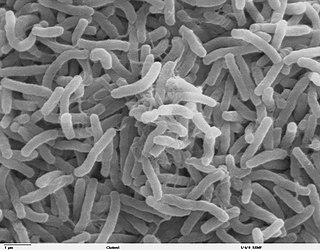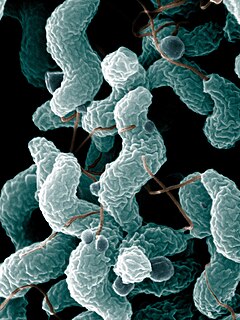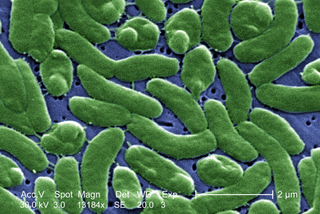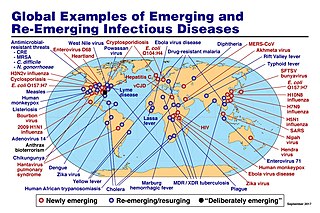
Vibrio cholerae is a species of Gram-negative, facultative anaerobe and comma-shaped bacteria. The bacteria naturally live in brackish or saltwater where they attach themselves easily to the chitin-containing shells of crabs, shrimps, and other shellfish. Some strains of V. cholerae are pathogenic to humans and cause a deadly disease cholera, which can be derived from the consumption of undercooked or raw marine life species.

Campylobacter is a genus of Gram-negative bacteria. Campylobacter typically appear comma- or s-shaped, and are motile. Some Campylobacter species can infect humans, sometimes causing campylobacteriosis, a diarrhoeal disease in humans. Campylobacteriosis is usually self-limiting and antimicrobial treatment is often not required, except in severe cases or immunocompromised patients. The most known source for Campylobacter is poultry, but due to their diverse natural reservoir, Campylobacter spp. can also be transmitted via water. Other known sources of Campylobacter infections include food products, such as unpasteurised milk and contaminated fresh produce. Sometimes the source of infection can be direct contact with infected animals, which often carry Campylobacter asymptomatically. At least a dozen species of Campylobacter have been implicated in human disease, with C. jejuni (80–90%) and C. coli (5-10%) being the most common. C. jejuni is recognized as one of the main causes of bacterial foodborne disease in many developed countries. It is the number one cause of bacterial gastroentritis in Europe, with over 246,000 cases confirmed annually. C. jejuni infection can also cause bacteremia in immunocompromised individuals, while C. lari is a known cause of recurrent diarrhea in children. C. fetus can cause spontaneous abortions in cattle and sheep, and is an opportunistic pathogen in humans.

Lactobacillus is a genus of Gram-positive, aerotolerant anaerobes or microaerophilic, rod-shaped, non-spore-forming bacteria. Until March 2020, the genus Lactobacillus comprised over 260 phylogenetically, ecologically, and metabolically diverse species; a taxonomic revision of the genus in 2020 assigned lactobacilli to 25 genera.

The human microbiome is the aggregate of all microbiota that reside on or within human tissues and biofluids along with the corresponding anatomical sites in which they reside, including the skin, mammary glands, seminal fluid, uterus, ovarian follicles, lung, saliva, oral mucosa, conjunctiva, biliary tract, and gastrointestinal tract. Types of human microbiota include bacteria, archaea, fungi, protists and viruses. Though micro-animals can also live on the human body, they are typically excluded from this definition. In the context of genomics, the term human microbiome is sometimes used to refer to the collective genomes of resident microorganisms; however, the term human metagenome has the same meaning.

Vibrio is a genus of Gram-negative bacteria, possessing a curved-rod (comma) shape, several species of which can cause foodborne infection, usually associated with eating undercooked seafood. Typically found in salt water, Vibrio species are facultative anaerobes that test positive for oxidase and do not form spores. All members of the genus are motile. They are able to have polar or lateral flagellum with or without sheaths. Vibrio species typically possess two chromosomes, which is unusual for bacteria. Each chromosome has a distinct and independent origin of replication, and are conserved together over time in the genus. Recent phylogenies have been constructed based on a suite of genes.

The fecal–oral route describes a particular route of transmission of a disease wherein pathogens in fecal particles pass from one person to the mouth of another person. Main causes of fecal–oral disease transmission include lack of adequate sanitation, and poor hygiene practices. If soil or water bodies are polluted with fecal material, humans can be infected with waterborne diseases or soil-transmitted diseases. Fecal contamination of food is another form of fecal-oral transmission. Washing hands properly after changing a baby's diaper or after performing anal hygiene can prevent foodborne illness from spreading.

Vibrio vulnificus is a species of Gram-negative, motile, curved rod-shaped (bacillus), pathogenic bacteria of the genus Vibrio. Present in marine environments such as estuaries, brackish ponds, or coastal areas, V. vulnificus is related to V. cholerae, the causative agent of cholera. At least one strain of V. vulnificus is bioluminescent.

The Vibrionaceae are a family of Proteobacteria given their own order, Vibrionales. Inhabitants of fresh or salt water, several species are pathogenic, including the type species Vibrio cholerae, which is the agent responsible for cholera. Most bioluminescent bacteria belong to this family, and are typically found as symbionts of deep-sea animals.

In infectious disease ecology and epidemiology, a natural reservoir, also known as a disease reservoir or a reservoir of infection, is the population of organisms or the specific environment in which an infectious pathogen naturally lives and reproduces, or upon which the pathogen primarily depends for its survival. A reservoir is usually a living host of a certain species, such as an animal or a plant, inside of which a pathogen survives, often without causing disease for the reservoir itself. By some definitions a reservoir may also be an environment external to an organism, such as a volume of contaminated air or water.

An emerging infectious disease (EID) is an infectious disease whose incidence has increased recently, and could increase in the near future. The minority that are capable of developing efficient transmission between humans can become major public and global concerns as potential causes of epidemics or pandemics. Their many impacts can be economic and societal, as well as clinical. EIDs have been increasing steadily since at least 1940. For every decade since 1940, there has been a consistent increase in the number of EID events from wildlife-related zoonosis. Human activity is the primary driver of this increase, with loss of biodiversity a leading mechanism.
An emergent virus is a virus that is either newly appeared, notably increasing in incidence/geographic range or has the potential to increase in the near future. Emergent viruses are a leading cause of emerging infectious diseases and raise public health challenges globally, given their potential to cause outbreaks of disease which can lead to epidemics and pandemics. As well as causing disease, emergent viruses can also have severe economic implications. Recent examples include the SARS-related coronaviruses, which have caused the 2002-2004 outbreak of SARS (SARS-CoV-1) and the 2019–21 pandemic of COVID-19 (SARS-CoV-2). Other examples include the human immunodeficiency virus which causes HIV/AIDS; the viruses responsible for Ebola; the H5N1 influenza virus responsible for avian flu; and H1N1/09, which caused the 2009 swine flu pandemic. Viral emergence in humans is often a consequence of zoonosis, which involves a cross-species jump of a viral disease into humans from other animals. As zoonotic viruses exist in animal reservoirs, they are much more difficult to eradicate and can therefore establish persistent infections in human populations.

Pathogenic bacteria are bacteria that can cause disease. This article focuses on the bacteria that are pathogenic to humans. Most species of bacteria are harmless and are often beneficial but others can cause infectious diseases. The number of these pathogenic species in humans is estimated to be fewer than a hundred. By contrast, several thousand species are part of the gut flora present in the digestive tract.

Streptococcus iniae is a species of Gram-positive, sphere-shaped bacterium belonging to the genus Streptococcus. Since its isolation from an Amazon freshwater dolphin in the 1970s, S. iniae has emerged as a leading fish pathogen in aquaculture operations worldwide, resulting in over US$100M in annual losses. Since its discovery, S. iniae infections have been reported in at least 27 species of cultured or wild fish from around the world. Freshwater and saltwater fish including tilapia, red drum, hybrid striped bass, and rainbow trout are among those susceptible to infection by S. iniae. Infections in fish manifest as meningoencephalitis, skin lesions, and septicemia.
Vibrio campbellii is a Gram-negative, curved rod-shaped, marine bacterium closely related to its sister species, Vibrio harveyi. It is an emerging pathogen in aquatic organisms.
Vibrio furnissii is a Gram-negative, rod-shaped bacterium. Its type strain is ATCC 35016. V. furnissii is aerogenic (gas-producing), and uses L-rhamnose, L-arginine, L-arabinose, maltose, and D-mannitol, but not L-lysine, L-ornithine, or lactose. It has been isolated from patients with gastroenteritis, bacteremia, skin lesions, and sepsis.
Vibrio coralliilyticus is a Gram-negative, rod-shaped bacterium. It has a polar flagellum that is used for motility and has been shown to be critical for its virulence to corals. It is a versatile pathogen, impacting several marine invertebrates including Pocillopora damicornis corals, both the Pacific and Eastern Oyster’s larvae and some vertebrates such as the rainbow trout. It is a bacterium of considerable interest given its direct contribution to temperature dependent coral bleaching as well as its impacts on aquaculture where it can contribute to significant mortalities in larval oyster hatcheries. There are several known virulent strains, which appear on both the Pacific and Atlantic Coasts of the United States. After its initial discovery some strains were incorrectly classified as Vibrio tubiashii including the RE22 and RE98 strains but were later reclassified as Vibrio coralliilyticus.
Vagococcus fluvialis is a species of bacteria. The type strain of V. fluvialis is NCDO 2497. It rarely causes human infection. The only genetically proven case of V. fluvialis endocarditis was detected in the Cochin, India.
Helicobacter canadensis is a bacterium in the Helicobacteraceae family, Campylobacterales order, first isolated from humans with diarrhea. Its genome has been sequenced.
Microbiomes of the built environment is a field of inquiry focusing on the study of the communities of microorganisms found in human constructed environments. It is also sometimes referred to as "microbiology of the built environment".

Melanie Blokesch is a German microbiologist. Her research focuses on Vibrio cholerae, the bacterium causing cholera. She is a professor of life sciences at École Polytechnique Fédérale de Lausanne (EPFL), where she heads the Laboratory of Molecular Microbiology.












